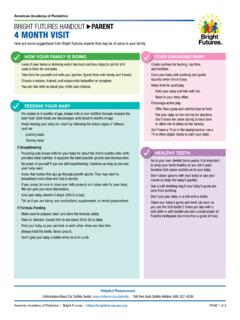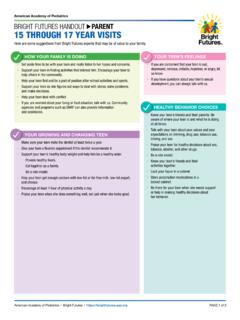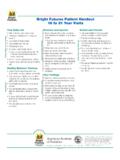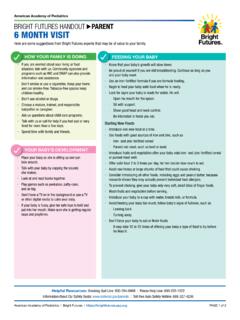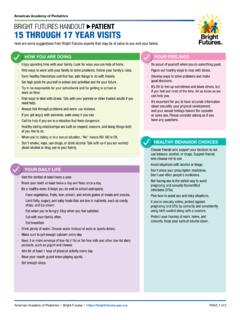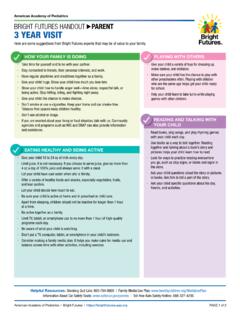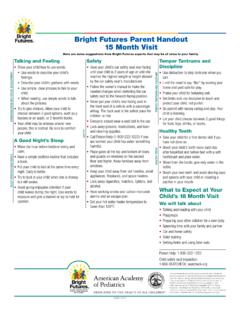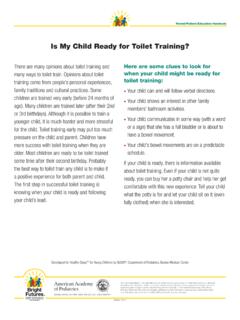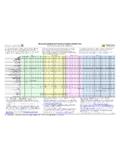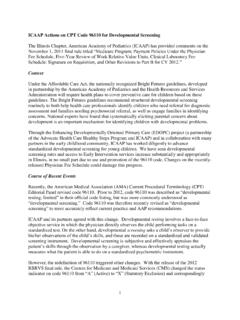Transcription of Bright Futures Parent Handout 9 and 10 Year Visits
1 HOW YOUR FAMILY IS DOING Encourage your child to be independent and responsible. Hug and praise him. Spend time with your child. Get to know his friends and their families. Take pride in your child for good behavior and doing well in school. Help your child deal with conflict. If you are worried about your living or food situation, talk with us. Community agencies and programs such as SNAP can also provide information and assistance. Don t smoke or use e-cigarettes. Keep your home and car smoke-free. Tobacco-free spaces keep children healthy. Don t use alcohol or drugs. If you re worried about a family member s use, let us know, or reach out to local or online resources that can help.
2 Put the family computer in a central place. Watch your child s computer use. Know who he talks with online. Install a safety filter. YOUR GROWING CHILD Be a model for your child by saying you are sorry when you make a mistake. Show your child how to use her words when she is angry. Teach your child to help others. Give your child chores to do and expect them to be done. Give your child her own personal space. Get to know your child s friends and their families. Understand that your child s friends are very important. Answer questions about puberty. Ask us for help if you don t feel comfortable answering questions.
3 Teach your child the importance of delaying sexual behavior. Encourage your child to ask questions. Teach your child how to be safe with other adults. No adult should ask a child to keep secrets from parents. No adult should ask to see a child s private parts. No adult should ask a child for help with the adult s own private Futures Handout Parent 9 AND 10 YEAR VISITSHere are some suggestions from Bright Futures experts that may be of value to your Academy of Pediatrics STAYING HEALTHY Take your child to the dentist twice a year. Give your child a fluoride supplement if the dentist recommends it.
4 Remind your child to brush his teeth twice a day After breakfast Before bed Use a pea-sized amount of toothpaste with fluoride. Remind your child to floss his teeth once a day. Encourage your child to always wear a mouth guard to protect his teeth while playing sports. Encourage healthy eating by Eating together often as a family Serving vegetables, fruits, whole grains, lean protein, and low-fat or fat-free dairy Limiting sugars, salt, and low-nutrient foods Limit screen time to 2 hours (not counting schoolwork). Don t put a TV or computer in your child s bedroom. Consider making a family media use plan.
5 It helps you make rules for media use and balance screen time with other activities, including exercise. Encourage your child to play actively for at least 1 hour Academy of Pediatrics | Bright Futures | PAGE 1 of 2 Helpful Resources: Family Media Use Plan: Quit Line: 800-784-8669 | Information About Car Safety Seats: | Toll-free Auto Safety Hotline: 888-327-4236 SCHOOL Show interest in your child s school activities. If you have any concerns, ask your child s teacher for help. Praise your child for doing things well at school. Set a routine and make a quiet place for doing homework.
6 Talk with your child and her teacher about Academy of Pediatrics | Bright Futures | PAGE 2 of 2 The information contained in this Handout should not be used as a substitute for the medical care and advice of your pediatrician. There may be variations in treatment that your pediatrician may recommend based on individual facts and circumstances. Original Handout included as part of the Bright Futures Tool and Resource Kit, 2nd Edition. Inclusion in this Handout does not imply an endorsement by the American Academy of Pediatrics (AAP). The AAP is not responsible for the content of the resources mentioned in this Handout .
7 Web site addresses are as current as possible but may change at any American Academy of Pediatrics (AAP) does not review or endorse any modifications made to this Handout and in no event shall the AAP be liable for any such changes. 2019 American Academy of Pediatrics. All rights AND 10 YEAR Visits Parent SAFETY The back seat is the safest place to ride in a car until your child is 13 years old. Your child should use a belt-positioning booster seat until the vehicle s lap and shoulder belts fit. Provide a properly fitting helmet and safety gear for riding scooters, biking, skating, in-line skating, skiing, snowboarding, and horseback riding.
8 Teach your child to swim and watch him in the water. Use a hat, sun protection clothing, and sunscreen with SPF of 15 or higher on his exposed skin. Limit time outside when the sun is strongest (11:00 am 3:00 pm). If it is necessary to keep a gun in your home, store it unloaded and locked with the ammunition locked separately from the with Bright Futures : Guidelines for Health Supervision of Infants, Children, and Adolescents, 4th EditionFor more information, go to
